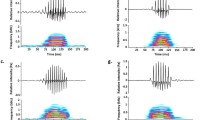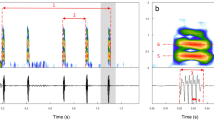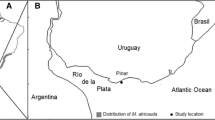Abstract
Several soniferous (sound-producing) fish species can generate a number of different call types, providing significant information for intended recipients and observers. Understanding the level of variation they are capable of and whether it is voluntary or not gives an indication of how individually specific their calls might be. Similar to other Sciaenidae, mulloway (Argyrosomus japonicus) produce calls associated with spawning behaviour by vibrating their swimbladder. Dissection revealed mature mulloway have bi-lateral, highly vascularised ‘sonic’ muscles, with dorsoventrally orientated muscle fibres along the posterior two-thirds of the swimbladder, similar to French meagre (A. regius). Repetitive contraction of these muscles likely impinges on the sides of a loosely supported swimbladder, to generate motion. In the Swan River, Western Australia, mulloway produce a category of ‘long’ calls comprising 11–32 contractions at pulse repetition intervals and resulting carrier frequencies of approximately 16.6 ms and 60 Hz, respectively. However, throughout the \(\approx \)0.3 s calls this repetition rate may stay constant, rise, fall or a combination. In 13% of analysed calls, a pre-call pulse of lower amplitude than subsequent pulses was observed. A category of short calls (1–5 pulses) employed carrier frequencies of up to 114 Hz initially, but this decreased with each pulse, suggesting that these calls are at the limit of contraction rates of the sonic muscles. The study shows that even within previously defined call categories mulloway have the ability to produce several variations. Whether these variations are generated voluntarily or not and whether they can be perceived by the intended recipient are unknown and suggested as a topic of further work.








Similar content being viewed by others
References
Kasumyan, A.O.: Sounds and sound production in fishes. J. Ichthyol. 48(11), 981–1030 (2008)
Fish, M.P., Mowbray, W.H.: Sounds of Western North Atlantic Fishes. Johns Hopkins, London (1970)
Engen, F., Folstad, I.: Cod courtship song: a song at the expense of dance? Can. J. Zool. 77, 542–550 (1999)
McCauley, R.D.: Biological sea noise in northern Australia: patterns of fish calling. Ph.D. thesis, James Cook University of North Queensland (2001)
Myrberg, A.A.J., Spires, J.Y.: Sound discrimination by the bicolour damselfish (Eupomacentrus partitus). J. Exp. Biol. 57, 727–735 (1972)
Myrberg, A.A.J., Ha, S.J., Shamblott, M.J.: The sounds of bicolor damselfish (Pomacentrus partitus): predictors of body size and a spectral basis for individual recognition and assessment. J. Acoust. Soc. Am. 94, 3067–3070 (1993)
Lagardere, J.P., Mariani, A.: Spawning sounds in the meagre Argyrosomus regius recorded in the Gironde Estuary, France. J. Fish Biol. 69, 1697–1702 (2006)
Ueng, J.P., Huang, B.Q., Mok, H.K.: Ontogenetic changes of sound production in Japanese croaker, Argyrosomus japonicus (Sciaenidae). J. Fish. Soc. Taiwan 26, 13–21 (1999)
Connaughton, M.A., Taylor, M.H., Fine, M.L.: Effects of fish size and temperature on weakfish disturbance calls: implications for the mechanism of sound generation. J. Exp. Biol. 203, 1503–1512 (2000)
Tavolga, W.N.: Fish Physiology, p. 532. Academic Press, New York (1971)
Parsons, M.J.G., Salgado-Kent, C.P., Marley, S.A., Gavrilov, A.N., McCauley, R.D.: Characterizing diversity and variation in fish choruses in Darwin Harbour. ICES J. Mar. Sci. 73(8), 2058–2074 (2016)
Griffiths, M.H., Heemstra, P.C.: A contribution to the taxonomy of the marine fish genus Argyrosomus (Perciformes: Sciaenidae), with descriptions of two new species from southern Africa. Ichthyol. Bull. 65, 1–41 (1995)
Rome, L.C.: Principles of actuation in the muscular system of fish. IEEE J. Ocean. Eng. 30, 630–646 (2005)
Rome, L.C., Swank, D., Corda, D.: How fish power swimming. Science 261, 340–343 (1993)
Connaughton, M.A., Fine, M.L., Taylor, M.H.: Use of sound for localization of spawning weakfish in Delaware Bay (USA) and effects of fish size, temperature and season on sound parameters. Bioacoustics 12(2–3), 294–296 (2002)
Lin, Y.C., Mok, H.K., Huang, B.Q.: Sound characteristics of big-snout croaker, Johnius macrorhynus (Sciaenidae). J. Acoust. Soc. Am. 121, 586–593 (2007)
Parsons, M.J.G., McCauley, R.D., Mackie, M.C.: Characterisation of mulloway advertisement sounds. Acoust. Aust. 41(3), 196–201 (2013)
Parsons, M.J.G.: Passive acoustic techniques for monitoring fish aggregations. In : An investigation into active and passive acoustic techniques to study aggregating fish species. Ph.D. thesis, Curtin University, pp. 131–297 (2009)
Watkins, W.A.: Harmonic interval: fact or artifact in spectral analysis of pulse trains’. In: Tavolga, W.N. (ed.) Marine Bio-Acoustics, vol. 2, pp. 15–42. Pergamon Press, Oxford (1967)
Mitchell, S.L., Poland, J., Fine, M.L.: Does muscle fatigue limit advertisement calling in the oyster toadfish Opsanus tau? Anim. Behav. 76(3), 1011–1016 (2008)
Sprague, M.W.: The single sonic twitch model for the sound production mechanism in the weakfish, Cynoscion regalis. J. Acoust. Soc. Am. 108(5), 2430–2437 (2000)
Connaughton, M.A., Fine, M.L., Taylor, M.H.: The effects of seasonal hypertrophy and atrophy on fiber morphology, metabolic substrate concentration and sound characteristics of the weakfish sonic muscle. J. Exp. Biol. 200, 2499–2557 (1997)
Nilsson, J.: Acoustic behaviour of spawning cod (Gadus morhua), Candidatus scientiarum thesis, University of Bergen (2004)
Ueng, J.P., Huang, B.Q.: Circadian rhythm of sound production in Japanese croaker, Argyrosomus japonicus. J. Fish. Soc. Taiwan 25, 287–292 (1998)
Ueng, J.P., Huang, B.Q., Mok, H.K.: Sexual differences in the spawning sounds of the Japanese Croaker Argyrosomus japonicus (Sciaenidae). Zoo. Stud. 46(1), 103–110 (2007)
Farmer, B.M., French, D.J.W., Potter, I.C., Hesp, S.A., Hall, N.G.: Determination of biological parameters for managing the fisheries for Mulloway and Silver Trevally in Western Australia. Fisheries Research and Development Corporation Report, 2002/004. (2005)
Parsons, M.J.G., McCauley, R.D., Mackie, M.C., Siwabessy, P.J., Duncan, A.J.: Localisation of an individual mulloway (Argyrosomus japonicus) within a spawning aggregation and their behavioural characteristics throughout a diel spawning period. ICES J. Mar. Sci. 66, 1007–1014 (2009)
McCauley, R.D., Thomas, F., Parsons, M.J.G., Erbe., C., Cato, D., Duncan, A.J., Gavrilov, A.N., Parnum, I.M., Salgado-Kent, C.P.: Developing an underwater sound recorder: the long and short (time) of it...Acoust. Aust. (2017) (in press)
Parsons, M.J.G., McCauley, R.D., Mackie, M., Siwabessy, P.J., Duncan, A.J.: A comparison of techniques for ranging close range mulloway (Argyrosomus japonicus) calls using a single hydrophone. Acoust. Aust. 38(3), 145–151 (2010)
Gavrilov, A.G., Parsons, M.J.G.: A Matlab toolbox for the characterisation of recorded underwater sound (CHORUS). Acoust. Aust. 42(3), 191–196 (2014)
Jensen, F.B., Kuperman, W.A., Porter, M.B., Schmidt, H.: Computational Ocean Acoustics, 1st edn, pp. 36–49. Beyer and AIP Press, New York (1997)
Silberschneider, V., Gray, C.A., Stewart, J.: Age, growth, maturity and the overfishing of the iconic sciaenid, Argyrosomus japonicus, in south-eastern, Australia. Fish. Res. 95, 220–229 (2009)
Parsons, M.J.G., McCauley, R.D., Mackie, M., Duncan, A.J.: In situ source levels of mulloway (Argyrosomus japonicus) calls. J. Acoust. Soc. Am. 132(5), 3559–3568 (2012)
Sprague, M.W., Luczkovich, J.J.: Measurement of an individual silver perch Bairdiella chrysoura sound pressure level in a field recording. J. Acoust. Soc. Am. 116(5), 3186–3191 (2004)
Parsons, M.J.G., Longbottom, S.V., Lewis, P., McCauley, R.D., Fairclough, D.V.: Sound production by the West Australian dhufish (Glaucosoma hebraicum). J. Acoust. Soc. Am. 134(4), 2701–2709 (2013)
Lobel, P.S.: Sounds produced by spawning fishes. Environ. Biol. Fish. 33(4), 351–358 (1992)
Colin, P.L., Clavijo, I.E.: Mass spawning by the spotted goatfish, Pseudupeneus maculatus (Bloch) (Pisces: Mullidae). Bull. Mar. Sci. 28(4), 780–782 (1978)
Mackie, M.C., McCauley, R.D., Gill, R.H., Gaughan, D.J.: Management and monitoring of fish spawning aggregations within the west coast bio-region of Western Australia. Fisheries Research and Development Corporation, Perth (2009)
Acknowledgements
The authors would like to acknowledge the Australian Government, via the Fisheries Research and Development Corporation (FRDC) for funding of this work. Mal Perry contributed substantial time and effort during the course of the project’s fieldwork. Department of Fisheries Western Australia has provided logistical support during the course of this study. The authors are also thankful for several useful comments made in reviewing the article.
Author information
Authors and Affiliations
Corresponding author
Rights and permissions
About this article
Cite this article
Parsons, M.J.G., McCauley, R.D. Sound Production by Mulloway (Argyrosomus japonicus) and Variation Within Individual Calls. Acoust Aust 45, 261–272 (2017). https://doi.org/10.1007/s40857-017-0112-9
Received:
Accepted:
Published:
Issue Date:
DOI: https://doi.org/10.1007/s40857-017-0112-9




